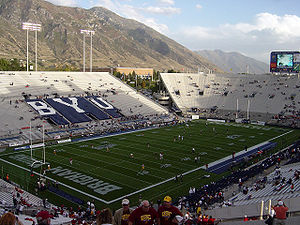- LaVell Edwards Stadium
-
LaVell Edwards Stadium Former names Cougar Stadium (1964-2000) Location 1700 N Canyon Rd,
Provo, UT 84604
 United States
United StatesCoordinates 40°15′27″N 111°39′16″W / 40.2575°N 111.65444°WCoordinates: 40°15′27″N 111°39′16″W / 40.2575°N 111.65444°W Opened 1964 Owner Brigham Young University Operator Brigham Young University Surface Natural grass Architect Fred L. Markham Capacity 63,725 Record attendance 66,247
(vs. Notre Dame, 1993)Tenants BYU Cougars (NCAA) (1964-present) LaVell Edwards Stadium is an outdoor athletic stadium in Provo, Utah, on the campus of Brigham Young University. Primarily used for college football, it is the home field of the BYU Cougars.
The playing field is natural grass and is at an elevation of 4630 feet (1411 m) above sea level. The field runs in the conventional nourth-south direction, with the press box along the west sideline.
Contents
History and seating
The stadium opened on the north end of campus in 1964 as Cougar Stadium, replacing a smaller, 5,000-seat stadium of the same name. The capacity of the facility was just under 30,000 with stands on both sides of the playing field. Seating was soon added to make room for 35,000 fans. Temporary bleachers placed at the back of the end zones raised the capacity to 45,000. The stadium was expanded in 1982 to accommodate more than 65,000; permanent concrete stands in the end zones, separated by entryways from the east and west grandstands, were put in place of the temporary bleachers. The playing field was lowered eight feet (2.4 m), and the running track was removed. Following the retirement of legendary head coach LaVell Edwards after the 2000 football season, the stadium was renamed in his honor.
To increase revenue, the stadium was renovated in 2003 to provide more luxury seating, which resulted in a slight reduction of seating capacity to 64,045. The luxury seating was a noticeable addition because the arrangement of blue and white seats in this section spell out BYU in block letters. On August 30, 2008, BYU unveiled a new video board on the north endzone, allowing fans seated in the south endzone to see the instant replays and graphics which previously were shown only on the south board. During the summer of 2010, the capacity of the stadium was further reduced due to some renovations that allowed for more wheelchair accessibility. Currently, a crowd of 63,725 (or more) is considered a sellout at LaVell Edwards Stadium.
Track and field
Prior to the 1982 expansion, the stadium hosted events for BYU's outdoor track and field teams. In fact, the stadium hosted the NCAA Track and Field Championships in 1967 and 1975.[1] With the removal of the track from Cougar Stadium (as it was still known at that time), a new track facility was built just south of the stadium - it was later named the Clarence F. Robison Track to honor the team's legendary former coach.
Jurassic fossils under the stadium
Part of the largest collection of Jurassic period fossils in North America, housed at BYU, was stored underneath the east bleachers of the stadium until 2005. The fossils have since been prepared and are on display in the BYU Earth Science Museum's collection room.[2][3][4]
Security
Due to installation of new features in the stadium, the grounds crew and BYU Police have installed a number of security features to prevent students from entering the stadium after hours, including security cameras and motion detectors. Anyone found entering the stadium after hours may be charged with trespassing and receive a fine.
Renovations and future expansion
The stadium will undergo some upgrades starting in the 2011 season, by 2012 the student section will be unified in one section instead of being scattered throughout the stadium, new HD jumbotrons will face the north and south endzones, replacing the outdated and smaller video screens. The twin towers have been freshly coated to reflect the new BYU "Blue" color scheme.
There has been talk of future expansion, but no date or details have been released.
Notes and references
- ^ BYUCougars.com - LaVell Edwards Stadium
- ^ "BYU Earth Science Museum". byu.edu. 2007-10-24. http://cpms.byu.edu/ESM/index.html. Retrieved 2007-10-24.
- ^ "BYU is home to North America's largest collection of Jurassic era fossils.". BYU Magazine, August 1993, 7-8. 1993-8. http://magazine.byu.edu/?act=view&a=930. Retrieved 2006-12-28.
- ^ "Museum Information". byu.edu. http://cpms.byu.edu/ESM/information.html. Retrieved 2008-10-26.
External links
- LaVell Edwards Stadium at BYUCougars.com
- Ballparks.com entry
- CollegeGridirons.com entry
- Stadium Seating and Eating Changes
Brigham Young University Business • Education • Engineering • Family, Home, and Social Sciences • Fine Arts and Communications • Health and Human Performance • Humanities • Law • Life Sciences • Nursing • Physical and Mathematical Sciences • Religious Education • Continuing Education • Honors ProgramMen's Basketball • Women's Basketball • Cougarettes • Football • Lacrosse • Rugby • Men's Soccer • Cosmo the Cougar • Cougar Fight SongY Mountain • Centennial Carillon Tower • Buildings (Harold B. Lee Library • LaVell Edwards Stadium • Marriott Center • Gordon B. Hinckley Alumni and Visitors Center • Museum of Art • BYU Jerusalem Center • Spencer W. Kimball Tower • Larry H. Miller Field • Smith Fieldhouse) • Residence hallsHonor Code • Choirs • BYU Television • Young Ambassadors • LDS Mission • Tantara Records • Academic freedom issues • ORCA Grant • The Daily Universe • Ballroom Dance Company • Vocal Point • Divine ComedyCollege football venues in Utah Division I
FBSPac-12 Rice–Eccles Stadium (Utah)
WAC Independent LaVell Edwards Stadium (BYU)
Division I
FCSBig Sky Great West Division II GNAC Categories:- BYU Cougars football
- College football venues
- Sports venues in Utah County, Utah
- BYU Cougars
- Brigham Young University buildings
- Event venues established in 1964
Wikimedia Foundation. 2010.


